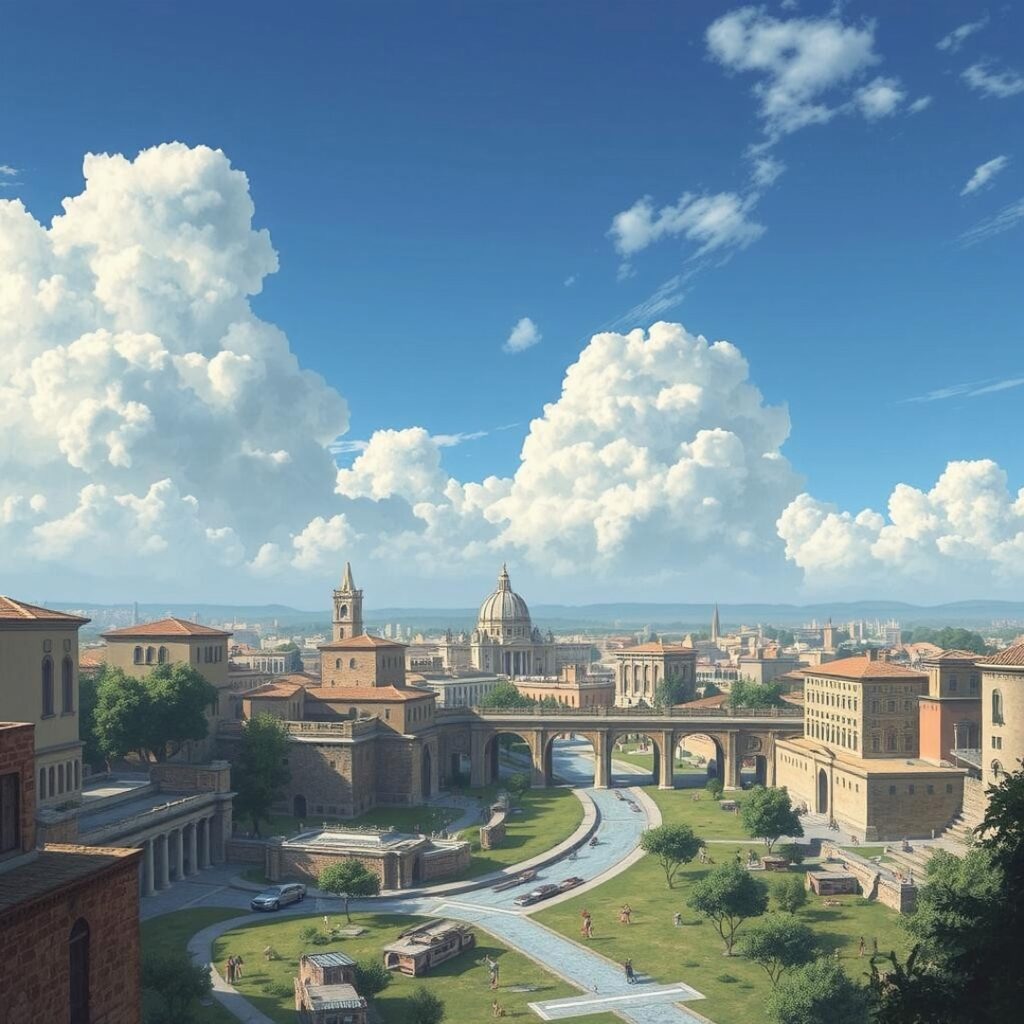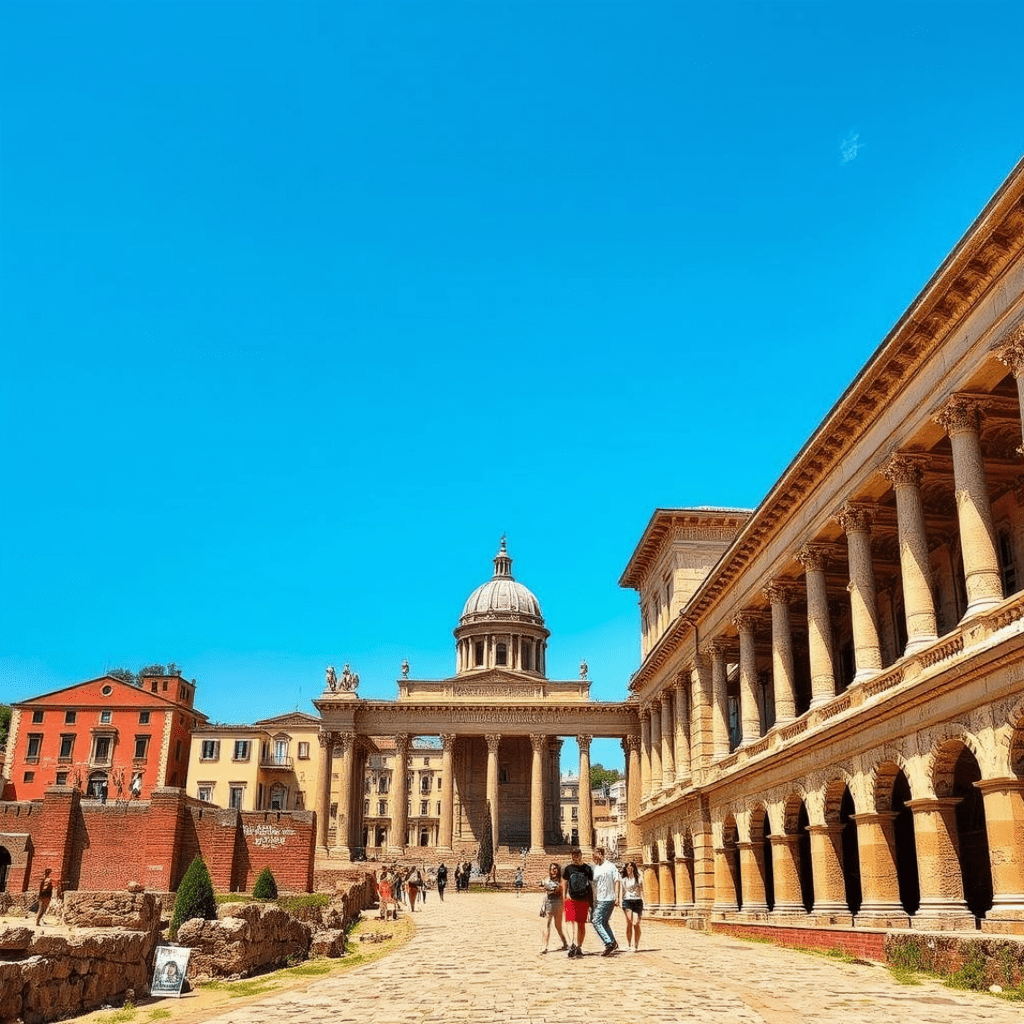The ancient Romans built cities that were both impressive and vulnerable to natural disasters. Their urban centers faced threats from earthquakes, floods, and plagues due to the geographical and geological characteristics of the Mediterranean region.
The Romans developed innovative strategies in urban planning that enhanced resilience against these calamities. Many of these principles remain relevant today, offering valuable insights for modern disaster management practices.
In this article, you will learn about:
- The historical context of Roman urban planning and its response to environmental risks
- The critical role of infrastructure, such as the Roman roads, in ensuring city resilience
- Architectural innovations that bolstered disaster preparedness
- Leadership strategies employed during calamities
- Lessons from Roman resilience applicable to contemporary urban challenges
However, it is essential to understand that daily life in ancient Rome varied significantly across different social classes. For instance, the patricians, who were wealthy landowners, lived a life of luxury and power, while the plebeians had a drastically different experience. This social class divide influenced every aspect of their lives including their response to disasters.
Moreover, it’s worth noting the cultural aspects of Roman society that have left a lasting impact on modern culture. The influence of Roman mythology on contemporary culture is an interesting subject worth exploring. Additionally, the role of gladiators in Roman entertainment raises intriguing questions about their status in society – whether they were seen as heroes or victims of the brutal games they participated in.

Historical Context of Roman Urban Planning
Ancient Rome faced significant geographical challenges that influenced its urban development. Situated in the Mediterranean region, the city was located in a seismically active zone. This proximity to tectonic plate boundaries heightened the risk of earthquakes. Additionally, the presence of water bodies nearby made parts of the city vulnerable to flooding, necessitating careful consideration in urban planning.
Key factors influencing city design included:
- Seismic Activity: Roman architects and builders adopted flexible building materials and construction techniques. These adaptations aimed to enhance structural integrity against tremors. For instance, the use of bricks and mortar allowed for some degree of flexibility, reducing the likelihood of catastrophic failures during seismic events.
- Urban Resilience: The historical significance of urban planning in Rome reflected not only the city’s power and sophistication but also its ability to respond effectively to environmental risks. Strategic layouts facilitated community safety during emergencies, while robust infrastructures like fortified walls offered protection from both natural disasters and external threats.
The Romans demonstrated their understanding of environmental challenges through innovative urban planning. This foresight established a model for resilience that has informed modern approaches to disaster management in contemporary cities facing similar risks. The legacy of their strategies continues to resonate today as cities navigate the complexities posed by climate change and urbanization pressures.
Moreover, urban planning in ancient Rome wasn’t solely about managing geographical challenges; it also played a crucial role in shaping social dynamics and reinforcing political authority. The city’s design facilitated public spectacles such as gladiatorial games and chariot races, which were not just forms of entertainment but also tools for political leverage and social cohesion.
The Twelve Tables, a significant milestone in Roman legal history, further illustrate how urban planning intersected with law and governance. Established between 451-450 BCE, these laws were the first attempt to codify the complex legal practices of ancient Rome, thereby laying the foundation for modern legal systems.
Understanding this historical context is essential for grasping the profound influence that ancient Rome has had on Western civilization. From its inception as a small city-state to its transformation into a vast empire, Rome’s legacy remains a cornerstone of Western civilization today.
Infrastructure: A Key Element of Resilience
City Walls: Protecting Against Disasters
Robust infrastructure was a crucial part of Roman city planning, serving as both a way to defend against attacks and ensure public safety. The construction of city walls is a prime example of this strategy.
- Defense Against Outside Threats: Thick stone walls surrounded cities, providing protection against invasions and potential disasters. These fortifications were vital in keeping the population safe during emergencies.
- Containment of Internal Disasters: During crises such as fires or epidemics, city walls helped contain the population, preventing panic and chaos. Historical accounts show how people sought shelter within these fortified areas during turbulent times.
The Romans used careful techniques to build these walls:
- Heavy Stone Blocks: The Romans used large stone blocks that made the walls stronger. This choice not only defended against attacks but also made the walls stable during earthquakes.
- Smart Positioning: Many cities were built on high ground, using the natural landscape to reinforce their defenses. This positioning gave them an advantage against both human and environmental threats.
Advanced Aqueduct Systems for Water Management
Another crucial part of Roman infrastructure was the aqueduct system, which brought clean water over long distances.
- Dependable Water Supply: During emergencies, having access to clean water was essential for survival. Roman aqueducts played a key role in preventing outbreaks of waterborne diseases, especially after disasters like earthquakes or floods.
To ensure these systems lasted long and worked well:
- Exact Gradients: Aqueducts were built with specific slopes to allow water to flow naturally using gravity. This precise engineering made sure water moved smoothly from its source to where it was needed without becoming stagnant.
- Regular Upkeep: Inspection points were built into aqueduct systems so that routine checks and repairs could be done. This proactive approach ensured any problems could be fixed quickly, keeping a steady supply of clean water flowing.
Incorporating strong infrastructure like city walls and advanced aqueduct systems greatly improved the ability of Roman cities to withstand natural disasters. These methods not only showcased their skilled engineering but also highlighted their dedication to public health and safety in the face of environmental challenges.
This resilience wasn’t just because of physical infrastructure; it was also supported by other factors such as agriculture, which played a significant role in Rome’s economic growth, or by historical figures like Scipio Africanus, whose military strategies changed the course of history. Additionally, cultural aspects such as the rise of Stoicism influenced societal values during this time period.

Architectural Innovations for Disaster Preparedness
Roman architectural design exemplifies ingenuity in creating structures that not only served aesthetic purposes but also prioritized seismic resistance. The strategic use of arches and vaults played a crucial role in enhancing the stability of buildings.
The Role of Arches in Seismic Resistance
Arches are curved structures that span an opening and support weight from above. In Roman architecture, arches were extensively used in bridges, aqueducts, and monumental buildings like the Colosseum.
- Weight Distribution: Arches distribute weight evenly across their curve, allowing them to bear heavy loads without collapsing. This characteristic makes them ideal for withstanding lateral forces during earthquakes.
- Flexibility: Unlike rigid structures, arches have a certain degree of flexibility. When subjected to seismic activity, they can absorb and dissipate energy through controlled deformations, reducing the risk of failure.
The Importance of Vaults in Structural Integrity
Vaults are architectural elements formed by extending an arch along a given length. They were commonly employed in large spaces such as basilicas, baths, and warehouses.
- Continuous Surface: Vaults provide a continuous surface that resists bending and buckling under vertical loads. This property enhances the overall stability of the building.
- Material Efficiency: By using vaults instead of flat ceilings, Romans could create expansive interiors with fewer supporting columns. This design not only maximized usable space but also minimized material usage, making structures lighter and more earthquake-resistant.
The Pantheon: A Case Study in Roman Engineering
A significant case study illustrating these principles is the Pantheon, renowned for its massive coffered dome. The dome’s design incorporates a circular opening (oculus) at the top, which not only reduces weight but also allows for natural light to enter.
- Coffered Design: The coffered design decreases material usage while maintaining strength and stability under seismic loads. It demonstrates how Romans skillfully combined aesthetics with structural performance.
- Use of Concrete: The Pantheon showcases the innovative use of concrete, particularly with volcanic ash (pozzolana). This combination resulted in durable materials capable of enduring both time and tremors.
The Pantheon stands as a testament to Roman engineering prowess, showcasing how innovative building materials combined with intelligent design can yield resilience against natural calamities.
Practical Solutions for Urban Resilience
Such architectural innovations reflect how Romans integrated practical solutions into their urban environments, ensuring their cities could withstand the challenges posed by nature.
- Site Selection: Romans carefully chose locations for their cities, avoiding areas prone to earthquakes or floods whenever possible.
- Building Regulations: They implemented building codes that mandated certain construction techniques and materials known for their seismic resistance.
- Community Preparedness: Romans emphasized community preparedness through public awareness campaigns and training programs on disaster response.
This adaptability and foresight are part of the broader narrative of Exploring Ancient Rome, a journey through time that reveals not just stories of conquest and expansion but also tales of innovation, culture, and governance that have left an indelible mark on the world.
The Romans were not merely builders; they were innovators who transformed the architectural landscape of their time. Their structures were not only functional but also served as a testament to their power and cultural identity, as seen in Roman architecture, which stands as masterpieces of ancient engineering.
Moreover, understanding the lives of plebeians, the common people of ancient Rome who were vital to the fabric of Roman society, adds another layer to comprehending the social dynamics of Rome. They represented the majority and significantly influenced the development of political and economic structures while living amidst these architectural marvels.
Organizational Leadership During Calamities
The role of Roman leaders was crucial in coordinating effective emergency responses during major disasters. A noteworthy example is the eruption of Mount Vesuvius in 79 AD, which devastated the cities of Pompeii and Herculaneum.
Key Aspects of Leadership Response:
- Coordination of Resources: Roman leaders organized efforts to mobilize resources for disaster recovery. They ensured that relief supplies reached affected areas promptly, providing essential aid to survivors.
- Restoration of Order: In times of chaos, effective leadership was vital for restoring social order. Leaders implemented measures to protect citizens from looting and exploitation while establishing communication channels for reporting needs and coordinating assistance.
- Historical Accounts: Ancient texts illustrate how prominent figures like Pliny the Elder played significant roles during crises. His writings documented the eruption’s impact and highlighted the importance of strong leadership in guiding rescue efforts.
- Community Engagement: Leaders engaged local communities to foster a sense of solidarity and resilience. This grassroots involvement proved essential in organizing recovery efforts, as citizens contributed their skills and resources to rebuild their neighborhoods.
- Long-term Planning: Roman leaders focused on long-term strategies for disaster preparedness. They developed policies that not only addressed immediate needs but also set the groundwork for future resilience.
Effective leadership during calamities exemplified the Romans’ understanding that organized efforts could significantly mitigate the impact of disasters, ensuring survival and recovery for their citizens. Their ability to mobilize resources effectively was supported by remarkable Roman engineering feats, which not only facilitated governance but also played a crucial role in disaster response. Furthermore, these events were often documented with great detail in historical texts, shedding light on the art and culture of ancient Rome, which flourished alongside its engineering prowess.
Lessons from Roman Resilience Strategies for Modern Cities Facing Natural Calamities
The urban planning methods of the Romans remain relevant today, particularly as cities confront the challenges of climate change. Current examples illustrate how ancient strategies can inform modern resilience:
1. Adaptation to Climate Change
Coastal cities like Venice and New Orleans face rising sea levels. Inspired by Roman aqueducts, these cities are investing in advanced drainage systems and flood barriers to protect against inundation.
2. Seismic Resilience
Cities located in earthquake-prone areas, such as San Francisco and Tokyo, are adopting construction techniques reminiscent of Roman architecture. The use of flexible materials and reinforced structures mirrors the Romans’ innovative approaches to stability.
Key takeaways for contemporary urban planners seeking to enhance disaster resilience include:
- Robust Infrastructure: Implementing strong building codes that prioritize structural integrity can mitigate risks associated with natural disasters.
- Water Management Systems: Investing in reliable water infrastructure is crucial for maintaining public health during crises, echoing the Roman emphasis on aqueducts and reservoirs.
- Community Engagement: Encouraging community involvement in disaster preparedness fosters a culture of resilience. Education programs can empower residents with knowledge about emergency protocols and resources.
- Leadership and Coordination: Effective leadership plays a vital role in managing disaster responses. Establishing clear communication channels ensures swift action during emergencies.
By integrating these lessons learned from history, modern urban planning can create resilient cities that withstand natural calamities while promoting sustainable growth.
The governance structure established during the Roman Republic serves as an example for modern democratic systems, highlighting the importance of robust political frameworks in managing urban resilience. Furthermore, understanding the ancient Roman religion which intertwined with every aspect of their lives, can provide insights into community engagement strategies today.
Additionally, the Corpus Juris Civilis, a significant achievement in legal history commissioned by Emperor Justinian I, illustrates how ancient laws can inform contemporary legal systems, especially in areas related to urban planning and disaster management.
Lastly, studying the Roman Army’s strategies, known for its operational effectiveness and structured approach, could inspire modern leadership strategies in disaster response management.
Conclusion: Embracing Resilience as a Way Forward for Urban Sustainability Amidst Uncertainties
The lessons learned from how Romans built resilient cities to withstand natural disasters are significant. Here are the key takeaways:
- Innovative Urban Planning: Romans designed cities with geographical risks in mind, using flexible building materials and structures that could withstand earthquakes.
- Strong Infrastructure: Robust fortifications and advanced aqueduct systems provided safety and ensured access to clean water, which was crucial during emergencies.
- Effective Leadership: Coordinated efforts after the eruption of Mount Vesuvius demonstrated the importance of leadership in helping communities recover from disasters.
These strategies are still relevant today. Modern urban planners can look to Roman methods, such as those used during the establishment of the Roman Republic, for inspiration on how to make cities more resilient against current issues like climate change and natural disasters. The lasting impact of these ancient practices highlights the need for proactive actions in creating sustainable cities that can handle uncertainty.
FAQs (Frequently Asked Questions)
What innovative strategies did the Romans use in urban planning to enhance resilience against natural calamities?
The Romans developed a range of innovative strategies in urban planning, including the use of flexible building materials, robust city walls, and sophisticated aqueduct systems. These features were designed to withstand earthquakes, floods, and other disasters, ensuring that their cities could endure environmental challenges.
How did Rome’s geographical location influence its urban development?
Ancient Rome was situated in a seismically active zone and near water bodies prone to flooding. This geographical context influenced city design significantly, as Romans had to implement architectural solutions and infrastructure that could mitigate the risks posed by these natural hazards.
What role did infrastructure play in Roman resilience against disasters?
Infrastructure was crucial for Roman resilience. Strong city walls protected against external threats and internal disasters like fires or epidemics. Additionally, sophisticated aqueduct systems ensured a reliable clean water supply, which was vital for disease prevention during crises.
What architectural innovations did the Romans implement to prepare for disasters?
Romans utilized arches and vaults in their architecture not only for aesthetic appeal but also for structural stability under seismic forces. Notable buildings like the Pantheon exemplify how engineering techniques were employed to ensure durability during earthquakes.
How did leadership impact disaster recovery in ancient Rome?
Roman leaders played a pivotal role in coordinating emergency responses following major disasters, such as the eruption of Mount Vesuvius. Effective leadership was essential for mobilizing resources and restoring order amidst chaos, demonstrating the importance of organized efforts during crises.
What lessons can modern cities learn from Roman resilience strategies?
Modern urban planners can draw valuable lessons from Roman strategies by incorporating proactive measures into city designs. This includes enhancing infrastructure resilience and community preparedness to address contemporary challenges like climate change impacts, sea-level rise, and increased seismic activity.

